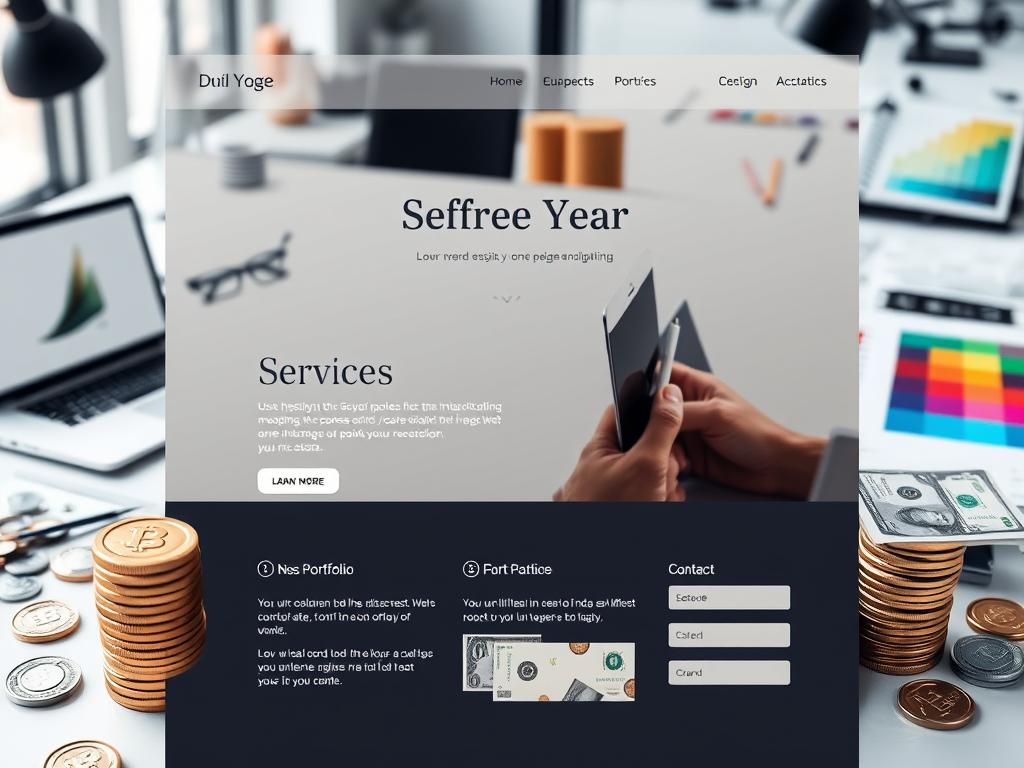Creating your own website without any cost is an appealing prospect for many, and with the myriad of free website building platforms available, it's entirely achievable. The process involves selecting the right platform, customizing your site, optimizing for search engines, and promoting your creation. However, there are key considerations and steps to follow to guarantee a professional and functional website. But how exactly can one navigate this terrain of free web development tools to bring their vision to life without breaking the bank?
Key Takeaways
- Utilize free website builders for cost-effective options.
- Choose platforms with easy design customization.
- Look for mobile responsive templates.
- Opt for platforms with SEO tools.
- Consider domain selection ease.
Choosing the Right Platform
When creating your own website, selecting the appropriate platform is a vital decision that will impact the functionality and design of your site. Conducting a platform comparison is necessary to determine which platform aligns best with your needs. Look for platforms that offer easy design customization options, allowing you to personalize your site to reflect your unique brand identity.
Furthermore, when choosing a platform, consider the ease of domain selection. A user-friendly platform should ease the process of selecting and linking your desired domain to your website seamlessly. This not only enriches your site's professionalism but also assists in brand recognition and credibility.
Moreover, a platform that offers SEO optimization tools is essential for increasing your website's visibility and attracting organic traffic. Secure that the platform provides features like meta-tag customization, keyword optimization, and mobile responsiveness to improve your site's search engine ranking and user experience. Selecting the right platform is fundamental to building a successful website that meets your objectives effectively.
Exploring Free Website Builders
When it comes to creating a website with no cost involved, utilizing free website builders is a popular choice among individuals and businesses alike. These platforms offer a range of features and customization options that cater to different needs and skill levels.
To make an informed decision, comparing the key features of various free website builders is essential in selecting the most suitable option for your project.
Free Website Builder Options
Exploring free website builders can be an important step in establishing your online presence without incurring costs upfront. When assessing free website builder options, it's essential to look for platforms that offer design templates and a user-friendly interface for a smoother website creation process. Here are some key features to take into account:
- Design Templates: Opt for a free website builder that provides a variety of design templates to choose from. These templates can give your website a professional appearance without the need for extensive design skills.
- User-Friendly Interface: Select a platform that offers an intuitive and easy-to-navigate interface. This will make it easier for you to customize your website, add content, and make updates as necessary.
- Mobile Responsiveness: Make sure that the free website builder you choose offers mobile responsiveness. With the growing use of mobile devices, it's vital that your website looks great and functions well on smartphones and tablets.
Key Features Comparison
An all-encompassing assessment of key features among various free website builders is important for selecting the most suitable platform for your online presence. When comparing functionality, consider the tools provided for website customization, e-commerce capabilities, and integration options.
Design options play a significant role in creating a visually appealing website, so evaluate the templates, themes, and customization flexibility offered by each platform.
Support availability is essential for resolving issues and getting assistance when needed. Look for platforms that offer reliable customer support through multiple channels such as live chat, email, or phone. Additionally, make sure the platform is mobile responsive to guarantee an ideal user experience on smartphones and tablets.
Before deciding on a free website builder, thoroughly examine the functionality comparison, design options, support availability, and mobile responsiveness to make an informed choice that aligns with your website goals and requirements.
Selecting a Domain Name
Selecting a domain name is a crucial step in establishing your online presence. When choosing a domain name for your website, consider the following:
- Domain Registration: Begin by registering your chosen domain name through a domain registrar. Look for registrars that offer free domain registration or affordable pricing options.
- Domain Extension Choices: Decide on the domain extension that best suits your website. Common extensions include .com, .org, .net, and country-specific extensions like .us or .uk. Choose an extension that reflects the nature of your website.
- Keyword Inclusion: Incorporate relevant keywords into your domain name to enhance search engine optimization (SEO) and make it easier for users to find your site. Keep the domain name concise, memorable, and reflective of your brand or website content.
Customizing Your Design
When customizing your website's design, attention to detail is key in creating a visually appealing and user-friendly interface. Start by selecting color schemes that reflect your brand and connect with your target audience. Consistency in colors throughout your website creates a unified look. Experiment with different fonts to find ones that are easy to read and align with the tone of your content.
Discover various layout options to organize your content effectively. Consider a clean and intuitive navigation menu to help users easily find what they are looking for.
A well-organized navigation system enriches the user experience and encourages visitors to delve deeper into your site.
Optimizing for SEO
To improve the visibility and ranking of your website on search engines, optimizing for SEO is vital. Implementing effective SEO strategies can greatly impact how your website performs in search results. Here are three key steps to optimize your website for better search engine visibility:
- Keyword Research: Conduct thorough keyword research to identify relevant terms and phrases that your target audience is searching for. Use tools like Google Keyword Planner or SEMrush to discover high-traffic keywords that you can strategically incorporate into your website content.
- On-Page SEO: Optimize your website's on-page elements such as title tags, meta descriptions, headings, and image alt text with your target keywords. Ensure that your content is well-organized, informative, and easy to read for both users and search engines.
- Quality Content: Create high-quality, engaging content that provides value to your audience. Regularly update your website with fresh, informative content that includes your target keywords naturally.
Adding Content and Images
Incorporating relevant and visually appealing content and images is crucial for enhancing the overall user experience and engagement on your website. When it comes to content creation, ensure that your text is informative, engaging, and applicable to your audience. Select images that are high-quality, related to your content, and visually attractive to capture your visitors' attention effectively.
Take into account the following factors when adding content and images to your website:
| Factors to Bear in Mind | Description | Importance |
|---|---|---|
| Relevance | Guarantee content aligns with your brand and target audience. | High |
| Quality | Utilize high-resolution images and well-written text. | Critical |
| Consistency | Sustain a consistent tone and style throughout your content. | Medium |
| Engagement | Integrate interactive elements like videos, infographics, or quizzes. | High |
| Optimization | Optimize images for web loading speed and format content for SEO. | High |
Integrating Social Media
When creating your website, incorporating social media widgets and share buttons is essential for enhancing user engagement and expanding your online presence.
Social media widgets allow you to display live feeds from your social platforms directly on your website, keeping visitors updated with your latest posts and activities.
Additionally, integrating share buttons enables users to easily share your content across various social networks, driving more traffic to your site and increasing its visibility on the web.
Social Media Widgets
Integrating social media widgets into your website is an essential step in enhancing user engagement and expanding your online presence. By incorporating these widgets, you can seamlessly connect your website visitors with your social media platforms, encouraging interaction and increasing your reach. Here are three key benefits of integrating social media widgets:
- Enhanced User Engagement: Social media widgets allow users to easily share your content, follow your social accounts, and engage with your brand, nurturing a sense of community and loyalty.
- Increased Visibility: By displaying social media feeds or buttons on your website, you can attract more visitors to your social profiles, expanding your online presence and driving traffic to your website.
- Improved Brand Credibility: Showing real-time social proof through widgets like live social feeds or follower counts can build trust with your audience and establish credibility for your brand.
Integrating social media widgets strategically can significantly boost your engagement strategies and overall social media engagement.
How can you effectively improve the social media presence of your website and encourage users to share your content across various platforms? Integrating share buttons is an essential step in maximizing the reach of your website. By strategically placing social media share buttons on your web pages, visitors can easily share your content with their network, increasing visibility and driving traffic back to your site.
Share buttons are interactive elements that allow users to share content directly to social media platforms like Facebook, Twitter, LinkedIn, and more. By incorporating these buttons on your website, you enable users to amplify your content to a broader audience within their social circles. This integration not only boosts your website's exposure but also enriches user engagement and interaction.
To integrate share buttons effectively, consider using plugins or embedding code provided by social media platforms. Customize the design and placement of share buttons to align with your website's aesthetics and user experience.
Regularly monitor social media analytics to track the performance of shared content and optimize your sharing strategy for maximum impact.
Setting Up Analytics
To effectively track and analyze the performance of your website, setting up analytics is essential. Analytics provide valuable perspectives into user behavior, helping you make informed decisions to enhance your site. Here are three key steps to set up analytics for your website:
- Choose an Analytics Platform: Select a free analytics tool like Google Analytics or Matomo to track visitors and measure performance. These platforms offer a wide range of metrics and features to help you comprehend how users interact with your site.
- Install Tracking Code: After signing up for an analytics platform, you will receive a unique tracking code. Copy and paste this code into the HTML of your website to start collecting data. This code will track visitors, page views, bounce rates, and more.
- Set Up Goals and Conversions: Define specific goals for your website, such as newsletter sign-ups or product purchases. By establishing goals and tracking conversions, you can measure the success of your site and make data-driven enhancements.
Going Live and Promoting
Launching your website and advertising it effectively are essential steps in gaining visibility and attracting visitors. One powerful way to drive traffic to your site is through social media marketing. Utilize platforms like Facebook, Instagram, Twitter, and LinkedIn to engage with your target audience, share valuable content, and advertise your website.
Develop a social media strategy that includes posting regularly, interacting with followers, and using targeted advertising to reach potential visitors.
Additionally, consider implementing email campaigns to reach out to your audience directly. Collect email addresses through sign-up forms on your website and send out newsletters, promotions, and updates to keep users engaged and informed about your website.
Frequently Asked Questions
Can I Create a Website Without Any Technical Skills?
Creating a website without technical skills is possible through user-friendly platforms that offer drag-and-drop builders. These tools allow individuals to design and customize websites without coding knowledge. By utilizing intuitive interfaces and pre-designed templates, users can easily create professional-looking websites.
Platforms like Wix, Weebly, and WordPress offer such features, enabling users to build their online presence effortlessly. With these tools, anyone can establish a website tailored to their needs and preferences.
Is It Possible to Have Multiple Domain Names for One Website?
Just as a symphony conductor harmonizes various instruments, domain management allows for multiple domain names to point to a single website. Through proper configuration, users can navigate seamlessly between different domain URLs while accessing the same content. This advanced feature improves user experience and simplifies website customization by catering to diverse audience preferences.
Leveraging domain management efficiently can streamline website operations and increase accessibility for visitors seeking specific content.
How Do I Ensure My Website Is Mobile-Friendly?
To guarantee your website is mobile-friendly, concentrate on responsive design tips, optimizing user experience. Prioritize speed optimization to boost mobile performance and incorporate SEO strategies for better visibility on search engines. Utilize tools like Google's Mobile-Friendly Test to assess your site's responsiveness.
Implement a mobile-first approach, simplify navigation, and optimize images for quick loading. Guaranteeing your website is mobile-friendly improves user engagement and enhances overall performance.
Can I Sell Products on My Free Website?
When considering e-commerce capabilities on a free website, it's important to evaluate available options for integrating payment gateways. While some free website platforms offer basic e-commerce functionality, they may have limitations on the number of products you can sell or transaction fees.
Researching and choosing a platform that supports your business needs and allows seamless integration of payment gateways is vital for a successful online store on a free website.
How Can I Protect My Website From Hackers and Malware?
To guarantee robust website security and protect your site from hackers and malware, implement essential measures such as using SSL certificates, regularly updating software, employing strong passwords, and installing security plugins.
Conduct routine security audits, backup your website frequently, and monitor for any suspicious activities.
Utilize firewalls and intrusion detection systems to fortify your defenses against cyber threats.
Stay vigilant and proactive in safeguarding your website from potential vulnerabilities.
Conclusion
In conclusion, creating a website for free is like planting a seed in fertile soil – with the right tools and care, it will flourish and grow. By selecting the right platform, customizing the design, optimizing for SEO, and integrating social media, your website will be ready to launch. Remember to monitor its progress with analytics and publicize it through various channels. With patience and dedication, your website will blossom into a successful online presence.








